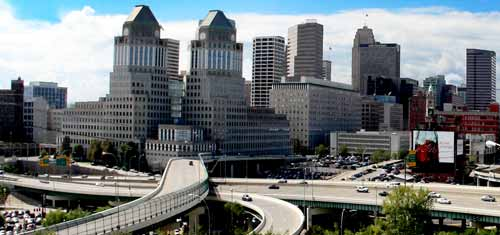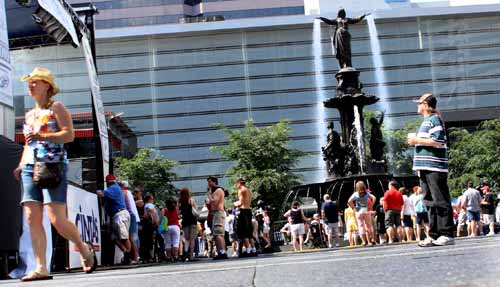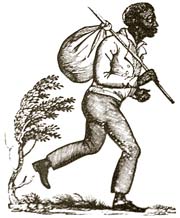Queen City of the West
Cincinnati Ohio
In 1784 John Filson who was living in the Louisville, Kentucky area published a book that is little known today, but when it was published, it became a big international hit. The title of this 1784 book was called The Discovery, Settlement and Present State of Kentucke. The only reason this is mentioned here is because in the appendix of this book, he wrote a section on the adventures of Daniel Boone which made so popularized the Boone, that he became part of our national heritage.

But success for John Filson was fleeting. He spent several years teaching school in Louisville, he unsuccessfully tried to start a seminary school, and he also worked as a surveyor. Filson also had legal and financial difficulties. At the height of these problems, perhaps looking to escape these difficulties, he purchased some land north of the Ohio River along with 2 other investors. Together, they purchased 800 acres of land on the north side of the Ohio River where the Licking River coming out of Kentucky enters the Ohio. Being an educated man, he gave the area the unlikely name of Losantiville which was a combination of a lot of words from 3 different languages (Latin, Greek, French) that no one really understood except for John. That was in 1788.

Filson immediately set out surveying the trio's purchase. Filson's survey and plan of the town survives today in the layout of modern downtown Cincinnati. Later that year, John Filson disappeared when Shawnee warriors attacked his surveying party on an expedition to survey the land near the Great Miami River. His 2 partners, Colonel robert Patterson and Mathias Denman (Denman represented a group of east coast speculators) transferred Filson's 1/3 ownership over to another surveyor, Israel Ludlow.
 Ludlow continued the surveying process and laid out the new town on a grid system based on a north/south and east/west configuration. This looked great on paper, but in practice, the plan completely ignored the topography of the area. Ludlow also ignored future consideration of the city by not including any parks or public space, except for some land along the river.
Ludlow continued the surveying process and laid out the new town on a grid system based on a north/south and east/west configuration. This looked great on paper, but in practice, the plan completely ignored the topography of the area. Ludlow also ignored future consideration of the city by not including any parks or public space, except for some land along the river.
In the same year that Filson was laying out Losantiville, 2 other communities were being created. Columbia was located just west of the Little Miami River and North Bend to the west. Both Columbia and North Bend had geographic problems in their location: the Ohio River was prone to frequent flooding which became more apparent as more settlers arrived. In a very short period of time, the Losantiville location became the star attraction of the triple crown of southeastern Ohio.
Because of conflicts between Native Americans living north of the Ohio River, it was decided a fort was needed to protect those early settlers. In 1789 a fort was built on a the flood plain overlooking the river where today is located E. Fourth Street. Just south is a small marker on Arch St. designating the location of Fort Washington.
In 1790, General St. Clair assumed command of Fort Washington and using his military powers promptly changed the name of the nearby village to Cincinnati, to honor the Society of Cincinnati which he was a member. The Society of Cincinnati was an organized group of military officers from the Revolutionary War.
During the first 40 years after its founding, Cincinnati experienced spectacular growth. By
1820, citizens, extremely proud of their city, were referring to it as The Queen City or The Queen
of the West. On May 4, 1819, B. Cooke wrote in the Inquisitor and Cincinnati Advertiser, "The
City is, indeed, justly styled the fair Queen of the West: distinguished for order, enterprise,
public spirit, and liberality, she stands the wonder of an admiring world."
With the introduction of the steam boat, Cincinnati really took off. Not only did the steam boat enable local farmers to get their crops to other markets along the Ohio River, Cincinnati became a builder of steam powered boats. In fact, at the high point of river steam boats, more than 1/4 of all of them were produced in Cincinnati.
In 1829, the Miami Canal was built connecting Cincinnati with Dayton. Later the canal would be extended to lake Erie and became the Miami Erie Canal.
 With easy access from the Ohio and the canal, Cincinnati was a boom town and a magnate for immigrants coming from the east coast, particularly German immigrants.
With easy access from the Ohio and the canal, Cincinnati was a boom town and a magnate for immigrants coming from the east coast, particularly German immigrants.
Cincinnati's prime industries were metalworking, wood products, and pork packing. By 1835, Cincinnati was the nation's pork packing center. It was even given the nickname Porkopolis. Hundreds of pigs would move through the downtown streets on their way to the slaughterhouse. One of the side industries resulting from so much pork processing, was the manufacturing of candles and soap. One of those industries was Procter and Gamble which started in 1837.
So much success resulted in Cincinnati's meat packing industry that city leaders failed to realize that their success had to be insured for the future. When railroads first started appearing across the state, Cincinnati failed to fully implement this new technology into their development. In short time, the railroads overtook river traffic and Cincinnati soon lost its place as the meat packing center, being replaced by Chicago and St. Louis.
With the large influx in German immigrants, Cincinnati like Columbus, became known for their quality beer brewing. From 1840 to 1850 the German population had more than doubled. German was taught in the local schools. The city had 4 German language newspapers. This strong German influence continued through until World War I when anti-German sentiments resulted in the end of an era.
So when did Cincinnati become known as the Queen City? Some say it was in 1854, Henry Wadsworth Longfellow wrote his poem, Catawba Wine, to memorialize the city's vineyards,
especially those of Nicholas Longworth. The last stanza of the poem reads:
"And this Song of the Vine,
This greeting of mine,
The winds and the birds shall deliver,
To the Queen of the West,
In her garlands dressed,
On the banks of the Beautiful River."

Underground Railroad's Main Depot
As a border city, Cincinnati reflected both Southern and Northern characteristics. Although escaping slaves passed through the area by the 1000s, few remained in the area because it was too close to the slave-state Kentucky. Bounting hunters continually scoured the area for any blacks that could be turned in for the reward.
During her stay in Cincinnati, Harriet Beecher Stowe became enveloped in the anti-slavery and later wrote her book Uncle Tom's Cabin as result of her experience on the Underground Railroad.
As a recognition Cincinnati's importance in the Underground Railroad movement, the National Underground Railroad Freedom Center is located in the heart of Cincinnati. This impressive center is consistently rated as one of the top-ranked visitor experiences in Cincinnati.

National Underground Railroad Freedom Center
50 East Freedom Way
Cincinnati
Open: 11 a.m. - 5 p.m. Tuesday through Sunday
(closed Sunday during home football games)
Cincinnati Fire Museum
Located in a 1907 National Register firehouse, the museum preserves and exhibits Greater Cincinnati's firefighting artifacts while honoring all the heroic firefighters, past and present.
315 W. Court St. Cincinnati, Ohio 45202 (513) 621-5553
Cincinnati Museum Center
Cincinnati Museum Center at Union Terminal is home to the Cincinnati History Museum, Cinergy Children's Museum, the Museum of Natural History & Science, the Robert D. Lindner Family OMNIMAX Theater and the Cincinnati Historical Society Library.
1301 Western Ave. Cincinnati, Ohio 45203 (513) 287-7000
Findlay Market
Visit Ohio's oldest continuously operated market.
1801 Race Street, Cincinnati, OH 45202 Phone: 513-665-4839
German Heritage Museum
The German Heritage Museum serves as the focal point in presenting and displaying German-American culture. This museum is the first of its kind in the region, and a testament to the many contributions German immigrants and their descendants have made toward the building of the Ohio Valley and America.
4790 West Fork Road Cincinnati, Ohio 45247 (513) 598-5732
Harriet Beecher Stowe House
The Harriet Beecher Stowe House is operated as an historical and cultural site, focusing on Harriet Beecher Stowe, author of Uncle Tom's Cabin. The site also includes a look into the family, friends, and colleagues of the Beecher-Stowe family, Lane Seminary, and the abolitionist, women's rights and Underground Railroad movements in which these historical figures participated in the 1830's to 1860's, as well as African-American history related to these movements.
2950 Gilbert Ave. Cincinnati, Ohio 45206 (513) 751-0651
Loveland Castle
Harry Andrews built this stone castle in the 1920s on the bank of the Little Miami River. The castle hosts events year-round, including a haunted castle in October. Other activities include picnic facilities, games and tours.
12025 Shore Road Loveland, Ohio 45140 (513) 683-4686
Cincinnati Observatory
Situated atop the rolling hillsides of Mt. Lookout, the Observatory is home to the world's oldest telescope still in use nightly by the general public. Two handsome National Historic Landmark buildings; one designed in 1873 by Samuel Hannaford, complement the institutions park-like setting.
Verdin Bell & Clock Museum
The sound of Verdin bells rings from more than 30,000 churches and cathedrals while our clocks, street clocks and towers beautify and enhance thousands of communities, colleges, shopping malls, and public spaces throughout the world.
444 Reading Road Cincinnati, Ohio 45202 (513) 852-2787
Waldschmidt Homestead Historical Site
The Waldschmidt Homestead is a fully-restored 1804 home on its original site. Built by Christian Waldschmidt, a Revolutionary War veteran, the homestead was settled as part of the Ohio frontier’s New Germany community (now Camp Dennison). Camp Dennison was the site of the Union army’s largest training installation. The property has been open for public tours since 1952, and is privately funded and operated by the Ohio Society of the Daughters of the American Revolution. Group tours of all ages are welcome. Educational programs, including a Boy Scout American Heritage Badge program, are available.
7567 Glendale-Milford Road Cincinnati, OH 45111 (513) 576-6327
William Howard Taft National Historic Site
The William Howard Taft National Historic Site commemorates the only man to serve as President and Chief Justice of the United States. The house that Taft was born in has been restored to its original appearance.
2038 Auburn Ave. Cincinnati, Ohio 45219 (513) 684-3262
Cincinnati Reds Hall of Fame & Museum
Any Cincinnati Reds fan will want to see the Cincinnati Reds Hall of Fame & Museum. A palace for the fans! With the formation of the Cincinnati Red Stockings of 1869, professional baseball and America's passion for the sport were born, and grew, right here in Cincinnati. Now, for the first time, the Cincinnati Reds Hall of Fame and Museum offers fans of the Reds, and of baseball, the first comprehensive look into the sport's heralded past.
100 Main St., Cincinnati, Ohio 45202 (513) 765-7576
Cincinnati Zoo & Botanical Garden
Over 1.2 million people visit the zoo’s award-winning exhibits, 500 animals, and 3,000 plant species annually. You’ll find naturalistic habitats featuring animals from every continent and over 20 lush gardens. The Cincinnati Zoo is rated as one of the top zoo attractions in the nation.
3400 Vine St., Cincinnati, Ohio 45220 (800) 944-4776
Coney Island
Cincinnati's Coney Island features Sunlite Pool, the world's largest re-circulating swimming pool with 2+ acres and 3 million gallons of water fun plus the Zoom Flume, Pipeline Plunge and Cyclone water slides!
6201 Kellogg Ave., Cincinnati, Ohio 45228 (513) 232-8230
Kings Island
King's Island is a mini-vacation destination like no other in the Midwest, and offers families an array of dynamic activities, entertainment and fun that just won’t stop. The most popular seasonal theme park in the nation last year. Where else can families enjoy Hollywood in the Midwest, where stars from movies and television come to life every day of the summer?
6300 Kings Island Drive Mason, Ohio 45040 (513) 754-5700
The Beach Waterpark
With 49 of the most thrilling water rides and exciting attractions anywhere, including the Kahuna Beach and Volcanic Panic, the entire family can plunge into all the fun of summer at The Beach.
2590 Water Park, Drive Mason, Ohio 45040 (513) 398-7946






 Ludlow continued the surveying process and laid out the new town on a grid system based on a north/south and east/west configuration. This looked great on paper, but in practice, the plan completely ignored the topography of the area. Ludlow also ignored future consideration of the city by not including any parks or public space, except for some land along the river.
Ludlow continued the surveying process and laid out the new town on a grid system based on a north/south and east/west configuration. This looked great on paper, but in practice, the plan completely ignored the topography of the area. Ludlow also ignored future consideration of the city by not including any parks or public space, except for some land along the river. With easy access from the Ohio and the canal, Cincinnati was a boom town and a magnate for immigrants coming from the east coast, particularly German immigrants.
With easy access from the Ohio and the canal, Cincinnati was a boom town and a magnate for immigrants coming from the east coast, particularly German immigrants.
